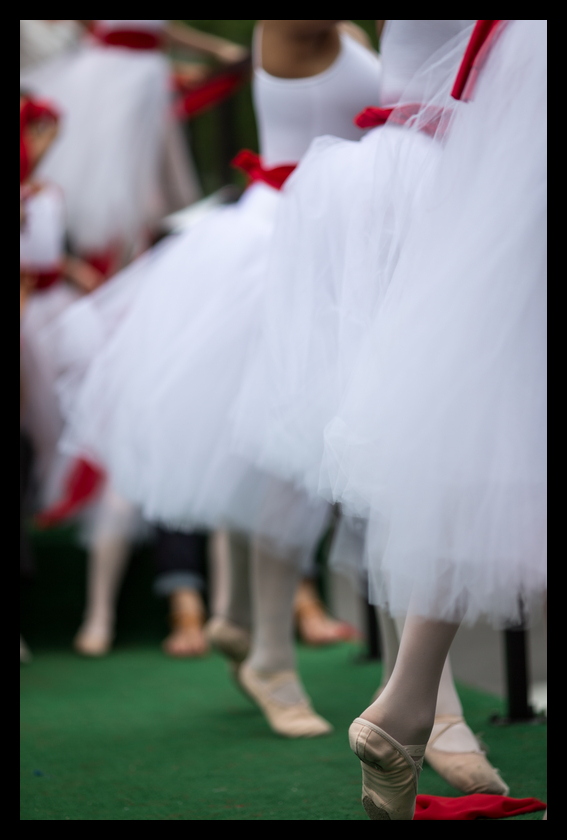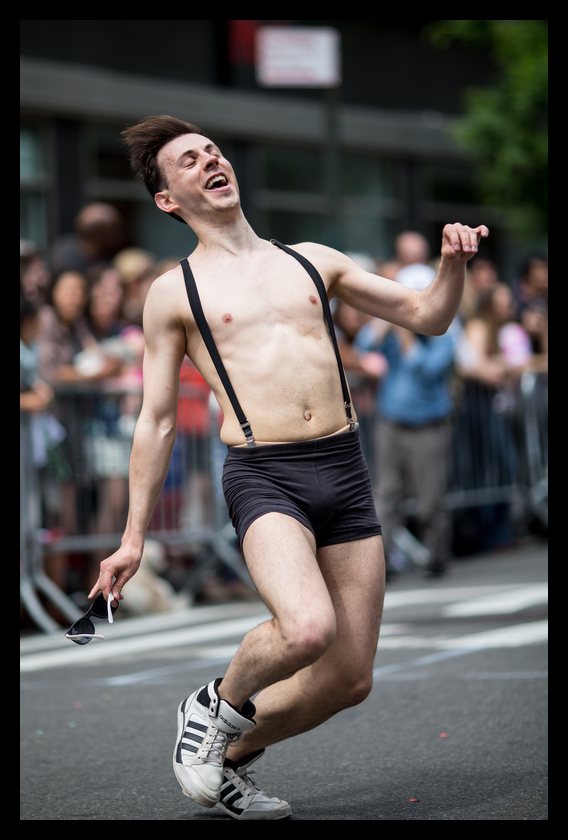There are times I love, absolutely LOVE New York City. Saturday May 16th was such a day. The 9th Annual Dance Parade held that day combined some of the best things the City has to offer: spectacle, exuberance and international and cultural diversity. Add some colors and you've got a great photographic opportunity.
Consider this an evergreen article. It's written after the parade, but hopefully helpful for photographers wondering what to keep in mind when shooting this parade and similar ones in the coming years. Next year, I'll give a heads up before the parade actually happens.
The Route
The parade wound down from Broadway and 21th Street to University Place, turned east onto 8th Street toward Astor Place and ended at Tompkins Square Park for DanceFest, a post-parade dance festival. At a grandstand for spectators on the corner of University Place and 8th Street, the dancers gave a short performance for the audience.
Like with any New York parade, you can find a spot along the route and shoot from behind the barricades. With relatively thin crowds at the start of the parade, this wasn't hard to do.
A better way is to get a parade pass. The organizers held a photo competition. If you sign up, you promise to enter the competition and give the organizers the right to use your images in their promotional materials in exchange for a pass to shoot from within the barricades. In essence, it's a temporary press pass and it works wonders with NYC cops along the route.
I arrived just before the start, picked up my (regular press) pass and started walking ahead. Initially, I was disappointed. There were hardly any people on the sidelines, a marked difference from other parades. It's the interaction of an engaged audience with the people in the parade that makes for a great atmosphere, so I feared a downer. My fear was ill-advised.
I kept on walking and settled for the corner at 8th Street, next to the grandstand. Not only was I assured of dance performances there, there was also a DJ pumping up the mood. In addition, the corner gave me the option of covering the parade from two sides, including head on. Most importantly, since the dancers approached from the north I was assured the light would be upon them to best highlight the colors of their outfits.
As you look for a spot to shoot from, another thing to keep in mind is that you don't want anything too prominent in the background. It's impossible to completely avoid shop signs when you're shooting in New York, but you can prevent the most distracting ones by picking the right place. You don't want the McDonald's arches in the background of all your shots, for example.
Gear Choices & Technique
Having never done this, I had no clue what equipment to take. I settled on the Canon 1D X that I recently bought for bird photography. For that camera, I brought my 24-70mm f/4 IS lens and the 70-200mm f/4 IS. I figured those lenses would give me enough coverage depending on whether I'd be far away from or close to the dancers. I also threw in the 135mm f/2 because I wondered how it would perform.
At first I was thinking of bringing my Canon 7D Mark II, also bought for bird photography after selling my 5D Mark III, but I decided against all that DSLR weight and packed an Olympus OM-D E-M1 as my second camera, partly to see how well it would deal with the speed of the dancers. For that camera, I brought the 12mm f/2 (24mm equivalent in full frame) and the 45mm f/1.8 lenses.
I started shooting with the 70-200mm on the 1D X, but looking at the images, I wasn't happy with the background clutter that the city is full of. Since it's a f/4 lens, it was hard to open wide enough to remove the clutter by limiting depth of field. So, I put the zoom lens away and mounted the 135mm, set the aperture at f/2, made sure the shutter speed was high and prayed that the 1D X would focus fast and accurately enough to give me good shots with limited depth of field.
Generally, I have a tendency not to be happy with my shots. This time, however, I loved many of them taken with the 1D X - 135mm combo. The combination of the razor-sharp focus on the subject and the buttery smooth out-of-focus area is delightful. And that 1D X just nailed it.
The only downside of using a relatively long prime lens and having limited space to move is that I couldn't quickly zoom out. So, sometimes hands reached beyond my frame and I couldn't do anything about it. Still, I'm not sure even the 70-200mm f/2.8 would create the strong separation between subject and background that the 135mm f/2 delivered.
I used fast shutter speeds, generally at or above 1/1250s. In my mind, when shooting dance you either freeze the movement at its height or you use really slow speeds to capture the flow of the movement. The latter would require a tripod, probably a neutral density filter and pose quite a challenge on the streets of Manhattan. I shot at the slower setting of three frames per second, figuring the maximum speed of 12 fps was more than I needed.
I ended up using the Olympus only with the 12mm lens. I set that also wide open to diminish the background clutter, but with an equivalent of 24mm and a depth of field as if the aperture was f/4, it was hard to get much separation. On the other hand, it was much easier to get things in focus. As such, the autofocus system didn't have to work very hard on the Olympus. The shutter did, though, because when I used this camera, the dancers would be very close to me. To get them just right in the frame, I let the camera rip at up to nine frames per second. If the subject is really close and you're using a wide angle lens, the movement is extremely fast and speed determines the difference between a leg placed just so that it leads you into the frame or a leg that doesn't go anywhere, visually speaking.
The Olympus did well, but I missed a wide angle with a more limited depth of field. Since I generally think of wide angle lenses as mostly for landscapes, I never bother with f/1.4 wide angle offerings. A parade like this would be an exception. A wide angle with limited depth of field on a relatively fast full-frame camera could deliver great images. Lesson for next time.
This and That
In general, nobody bothered me during an afternoon of shooting. A few times, in the beginning, the organizers asked me to move, which I did if I was indeed inadvertently blocking the view from the grandstand. Like in every crowd, some of my images had people stepping right in front of my lens. I even have my feet in some of the wide-angle shots, or the side of my hand. That happens.
I used the BlackRapid Yeti dual camera sling strap. This made me look like a dork, but worked well. The only problem was that I tend to keep the straps long and once I was sitting down, the Olympus regularly tumbled on the asphalt as it slipped off my leg or bag. I ended up shortening the strap. I had also taped up the corners of my cameras with gaffer tape, because I do have a tendency to become a klutz once I get into full shooting mode.
Three Thousand Frames...
I photographed for about 2.5 hours and got myself into trouble with 3375 frames on the memory cards. Very few of them were technically bad, so editing was quite time consuming. I used PhotoMechanic for the first cull and then imported about half of all images into Lightroom. A second edit left me with about three hundred images and the third and final edit will get got me to the 93 images I'll post I posted on Flickr.
Almost 3,500 frames might seem overkill, but with so much movement and around 10,000 dancers, it's easy to get there. You get caught up in the atmosphere, your powers of observation work overtime, your senses are on full alert. In other words: fun.
I'm not much of a dancer myself and my sense of rhythm is atrocious, but it was great to see and capture the sheer pleasure and exuberance of the dancers. Add to that the wonderful diversity of New York's population and ethnic cultures and you have a winning combination.
By John van Rosendaal















